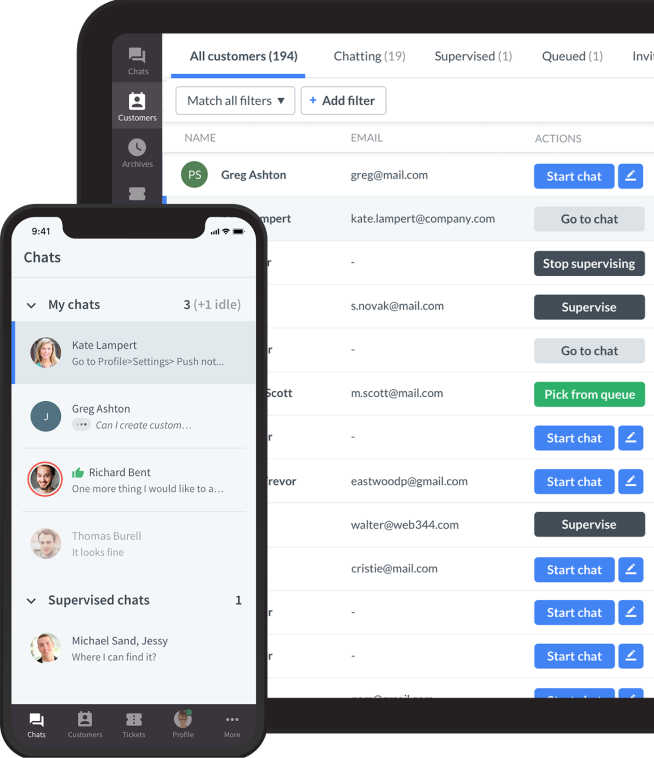
Being a customer success manager (CSM) is a piece of cake.
A cherry on top, after years of working in customer service. But is it, though? Well, it's not for me to judge. I'm here to bring you closer to all the job specifics and share the insights I got from LiveChat's Success Managers.
To better understand their role, let's recall what customer success is.
Customer success vs. customer support
Customer success is when customers achieve their desired outcome through interactions with your company. Contrary to customer support, where a customer comes to you with an issue and you solve it, customer success is about taking a proactive approach.
It’s reaching out to customers, taking care of them, targeting problems before they even happen, and trying to make changes in the product. Once you have that strategy, you can focus on the person responsible for it – the customer success manager.
What is a customer success manager, and what do they do?
A customer success manager ensures that customers achieve their desired outcomes and maximize the value they receive from a product or service. The CSM works closely with customers to understand their goals, identify potential roadblocks, and create strategies to overcome them.
To paint a picture of what a customer success manager’s work looks like, let me show you an example. Let's say you just bought a new smartphone, and you're excited to start using all its features, but you find that some things don't work as you expected. Maybe the battery life isn't as long as you thought, or you're having trouble setting up your email account. This is where a customer success manager comes in.
A success manager is like your personal guide, helping you make the most of your new purchase and overcome any challenges you might encounter.
They contact you shortly after you purchase the phone and ask about your experience. They listen to your concerns and questions and work with you to develop a plan to address them. They might recommend some apps to help you conserve battery life or provide step-by-step instructions for setting up your email. As you continue to use the phone, a customer success manager will check in with you periodically, offering tips and advice.
The goal of a customer success manager's job is to ensure that you have a positive experience with the product and that you're able to achieve your desired outcomes.
How customer success managers help increase customer retention and satisfaction
Customer success managers act as a bridge between the customers and the company, ensuring their needs are met and problems are solved quickly. Doing this increases customer retention and satisfaction because when customers feel supported and have positive experiences with a company, they're more likely to stick around and recommend it to others.
At LiveChat, to increase retention, we look for customer churn in a specific month of a customer's life cycle to find out which segment is our priority. Or we look closer at our MRR (Monthly Recurring Revenue) and see how it is reflected in the churn. LiveChat has a good churn rate. It's around three percent, which is a low indicator in the SaaS industry. We don’t take it for granted and constantly check different segments to determine why customers leave. We come up with new strategies that will allow us to keep even more customers.
Knowing this, you can build a team of specialists and implement a customer success strategy in your company. But now, let's focus on the customer success manager skills required to do the job right.

Customer success manager skills
Interpersonal skills
Unsurprisingly, a Customer Success Manager must be an excellent verbal and written communicator. Talking with people should be a great pleasure for them. Otherwise, they will be tired of their jobs, which will resonate with customers.
However, if someone is not a people person but is always willing to help, the rest follows. They will just be more exhausted than those who love this stuff. Besides that, they should be fine as long as they keep learning.
Empathy
A customer success specialist needs to have the ability to empathize with customers. It's essential to look at things from their perspective to truly understand them. Success managers might show empathy by acknowledging a customer's frustration, actively listening to their concerns, and offering support to solve their problem. This helps build a stronger connection with the customer and increases the likelihood of retaining them.
Technical knowledge of the product
Knowing the product in and out is crucial. It’s the only way customer success managers can present the benefits and solutions suitable for the customer’s business. Since their job is to achieve the customer's desired outcome, they need to know what they have to offer to find the solution that will make customers happy.
As one of our customer success managers at LiveChat explained, "I’m in touch with prospective customers – businesses which are on trial and testing the tool. My priority is to check their requirements and goals and guide them to the best solution. Knowing the product is inevitable to get my job done."
Strategic thinking
Sometimes, customers use the product in many different ways, and it's crucial to adjust solutions to their individual needs. LiveChat is a great example, as some companies use this solution to increase their sales by let's say, reaching out to customers browsing their website. At the same time, other businesses treat it strictly as a tool to support and communicate with their customers. The ability to understand customers' motives allows managers to better communicate the solutions and, as a result, increase customer satisfaction.
Time management skills
Customer success managers need to be able to manage multiple projects at once, prioritize their workload, and meet deadlines. They usually work with a few customers simultaneously, so they must plan their time wisely. They need to be accountable and follow through with their commitments. This way, they can build trust with customers, improve their performance, and ultimately help drive the success of their company's customers.
Analytical thinking
As part of their job is to retain customers, CSMs need to analyze customer data, have vast industry knowledge, identify trends, and use that information to advise customers on how to use the product best. They should be able to use technology to automate processes and collect data on customer behavior. This helps to identify areas to improve and make data-driven decisions.
Sales and marketing skills
A customer success manager must understand sales and marketing techniques to feel good about upselling, cross-selling, and renewing customer contracts. It's nothing like cold selling, though. Working and talking with customers regularly gives you a clear picture of their needs. Whether it's a subscription upgrade or an additional product that could help them drive more sales, success managers see it firsthand and recommend the right solution.
Experience in customer support is a nice skill to have
There is no better place to learn about a product than working with the customer support team. Spending day and night shifts trying to solve customer issues in real time gives a great deal of knowledge about a company, its products and services, and the customer's perspective.
Working in customer support can also help develop necessary skills such as problem-solving, empathy, and communication, which are essential for customer success management. Plus, the resilience and ability to work under pressure gained from customer support experience are invaluable in the work of a customer success manager later.
A Customer success manager’s salary
The salary for a customer success manager can vary depending on various factors such as location, industry, experience, and company size.
According to data from Glassdoor, the estimated total pay for a customer success manager is $94,225 per year in the United States, with an average salary of $70,636 per year. However, salaries can range from $74,000 to over $120,000 depending on the factors mentioned above.

Location can significantly impact a salary, with cities like San Francisco, New York, and Boston typically paying higher wages due to the higher cost of living in those areas. When looking for a customer success manager job, note that the given numbers are often the base salary. You can expect bonuses, commissions, and other incentives, which can significantly impact the overall compensation.
Also, you can search for a job using different titles and responsibilities. Senior Customer Success Manager, Customer Onboarding Manager, Customer Success Operations Specialist, Customer Experience Manager, Client Success Manager, and Customer Service Manager - these roles have similar responsibilities, just different titles.
A customer success manager’s resume
Here are some tips for creating a robust customer success manager resume:
- Start with a strong summary statement: The statement should provide a brief overview of your relevant experience and skills. Use this section to highlight your strengths and to catch the hiring manager's attention.
- Focus on achievements: List your accomplishments rather than just listing your job responsibilities. Provide context by explaining the challenges you faced and your actions to overcome them. This will help the hiring manager understand the impact of your work.
- Highlight relevant experience: Tailor your resume to the job you are applying for by highlighting experience that is relevant to the position. This might include experience in customer support, sales, or account management.
- Showcase your skills: Include a section highlighting your most relevant skills, such as communication, problem-solving, and relationship-building. Use keywords from the job description to ensure your skills match the employer's requirements.
- Maintain a high quality: Use bullet points to make your resume easy to scan and proofread carefully to avoid any typos or grammatical errors. This will demonstrate your attention to detail and professionalism.
The purpose of a customer success team
Every team has its purpose. For one team, it's the highest satisfaction. For another, it’s increased revenue. Or it can be both. Defining a purpose will help the team in their everyday work.
According to Nils Vinje, Customer Success Expert and the Founder of Glide Consulting:
“The customer success team is typically responsible for everything that happens post-sale, including renewals, which are, in essence, more sales. They're responsible for most of the company’s revenue and protecting the cash flow. The management needs to see how the CS’s purpose connects to that revenue.”
It's good to have people with various skills on the team. If someone is a great listener and knows how to ask the right questions - this is the perfect person to conduct interviews and diagnose customers’ problems. And if somebody has a good manner and is eloquent, they can be responsible for product demos.
What brings them together is the need to put customers first and a willingness to always provide solutions.
Building relationships as a customer success manager
A customer success manager is the go-to person for helping customers get the most out of their purchased products or services. They get to build customer relationships and help them solve problems, which is always rewarding.
Most customer success managers also work with many different teams within a company. They might work closely with sales, product development, and marketing, which gives them a chance to learn a lot about how a company operates and how all the pieces fit together.
With the demand for customer success managers on the rise, there are plenty of opportunities to grow a career and find a job that's right for you.



